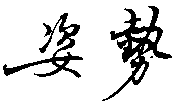

Standing exercise (posture 1)
The standing exercise described here will help your body get into the correct standing posture. A correct standing posture is very important because an incorrect posture will slow down your progress and cause harm to your body. Before standing, you should warm up your body first, especially those big joints such as the neck, shoulders, waist, hip, knees, and ankles.
Get into the standing posture described on the previous page. Stand with the knees only slightly bent for a couple of minutes, then do a series of abdominal breathing to calm the mind. (Click here to read more about abdominal breathing) When your mind is calmed, check your posture again from head to toe by the following:
Head: lift the head upward with the chin tucked in. Visualizing a string suspending your head at the crown (Bai-Hui GV20) will help.
Eyes and mouth: eyes look forward and relax. Close the lips lightly and touch your tongue to the palate.
Neck: the neck is pushed back and straightened out by the lifting of the head. This will straighten out the first curve of the spine.
Shoulders: the shoulders are dropped and relaxed.
Scapulas: the shoulder blades are loose, rounded and spread apart.
Chest: relax the chest and sink the sternum.
Arms: both arms are in front of the body and a little bit to the sides. Bend the arms so slightly that they have a gentle curve to them. Then rotate the both arms inward, creating a space in the armpit. Do not let the arms touch the body.
Fingers: the fingers are curved naturally with space in between each finger.
Pelvis: the pelvis is to be sunk down and tilted forward. This will push back the lumbar vertebrates and straighten out the second curve on the spine.
Spine: the spine needs to be straight, and perpendicular to the floor. The upward stretch at the neck and the downward stretch at the pelvis lengthen and straighten the spine, promoting a strong chi flow.
Sacrum: the tailbone is also tilted in (forward).
Perineum: the perineum is gently lifted, which also lifts and contracts the anus. Be aware not to squeeze too hard. That is inappropriate use of strength! (One of the Three Harms)
Leg: the leg is bent at the knee. The degree of this angle depends on your level of practice. Don’t over do this angle as it requires lots of leg strength, which will cause distractions in the beginning.
Knee: make sure your knee does not stick out over your toes.
Ankle: keep your ankles relaxed so your whole body weight can be transferred to your feet.
Feet: keep the feet parallel and they should be about shoulder width apart, but it could vary according to your body type. Choose whatever is comfortable. Keep the feet facing forward and flat on the ground.
Toes: toes grasp the floor gently. Don’t squeeze too hard.
Mind: the mind is calm and focused on the dantien.
After the posture is checked, turn your focus inward. Pay attention to subtle changes in your body and relax. After several minutes, repeat the checking procedure. when finish don't forget to close up with the Closing form.
Stand on this posture daily for at least 10 minutes to 30 minutes. At the beginning, most of this time is spent on correcting the posture. But as you progress, less time will be spent on the posture and more time will be spent on cultivating the chi, increase the benefits of standing.
After weeks of daily practices, you will feel very comfortable in standing. Then you may go on to other more advance postures or use it for standing meditation.
learning to stand naturally
You can also relearn Tree Standing naturally as in breathing. To begin, simply stand up naturally without any mental influence. By that I mean do not let your mind tells the body what to do. But instead, let the body tells you what to do. Your body actually knows how to stand. You will find your body moves into the posture as described above. First thing you will notice is the bending of the knee, then the straightening of the spine. The order might be different for everybody, but the resulted posture will be similar if not the same. This may take you more time to discover, but the advantage of this exercise is its simplicity. Give this a try, you might like this better because you don't have to memorize the posture.